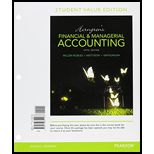
1.
Liabilities: Liabilities are debt and obligations of a business. These are the claims against the resources that a business owes to outsiders of the company. Liabilities may be short-term or long-term depending upon the time duration in which it is paid back to the creditors.
To Journalize: The transactions in the S Pharmacy’s general journal.
2.
To prepare: The liabilities section of the balance sheet for E pharmacies.
Want to see the full answer?
Check out a sample textbook solution
Chapter 12 Solutions
Horngren's Financial & Managerial Accounting, Student Value Edition Plus MyLab Accounting with Pearson eText -- Access Card Package (5th Edition)
- Shumpert, Inc., entered into a contract that was to take two years to complete, with an estimated cost of $1,736,000. The contract price was $2,430,400. Costs of the contract for 2023, the first year, totaled $1,302,000. If required, round any division to two decimal places and round your final answers to the nearest dollar. a. What was the gross profit reported by the percentage of completion method for 2023? 521,508 X b. After the contract was completed at the end of 2024 at a total cost of $1,822,800, what was the gross profit reported by the percentage of completion method for 2024? -1,215,908 X Feedback Check My Work Under the percentage of completion method, a portion of the gross contract price is included in income during each period as the work progresarrow_forwardGeneral accountingarrow_forwardAnswer? ? Financial accounting questionarrow_forward
 Financial Accounting: The Impact on Decision Make...AccountingISBN:9781305654174Author:Gary A. Porter, Curtis L. NortonPublisher:Cengage Learning
Financial Accounting: The Impact on Decision Make...AccountingISBN:9781305654174Author:Gary A. Porter, Curtis L. NortonPublisher:Cengage Learning Financial AccountingAccountingISBN:9781305088436Author:Carl Warren, Jim Reeve, Jonathan DuchacPublisher:Cengage LearningPrinciples of Accounting Volume 1AccountingISBN:9781947172685Author:OpenStaxPublisher:OpenStax College
Financial AccountingAccountingISBN:9781305088436Author:Carl Warren, Jim Reeve, Jonathan DuchacPublisher:Cengage LearningPrinciples of Accounting Volume 1AccountingISBN:9781947172685Author:OpenStaxPublisher:OpenStax College


